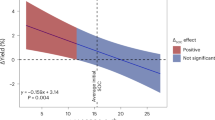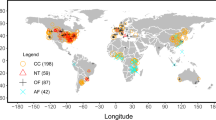Abstract
Cover crops are touted for their potential agronomic and environmental benefits, and are currently incentivized through state, federal and private investment in the USA. There is a need to quantify the impact of on-farm use of cover crops at temporal (2–5 years) and spatial (regional-to-national) scales aligned with such investment programmes. Here we report soil health data from a farmer-led trial of cover crops on 1,522 strip-years, from 78 farms across 9 US states over 5 years. We found that up to 5 years of cover crop use had small but increasing impacts on four of six selected soil health indicators, with active carbon concentration responding the most rapidly. Soil texture, the length of time a field was in the trial and a farm-level random effect were also strongly related to soil health properties. Our results fit with evidence from controlled trials and suggest that the use of cover crops can begin to influence soil health within several years after adoption.
This is a preview of subscription content, access via your institution
Access options
Access Nature and 54 other Nature Portfolio journals
Get Nature+, our best-value online-access subscription
$29.99 / 30 days
cancel any time
Subscribe to this journal
Receive 12 digital issues and online access to articles
$119.00 per year
only $9.92 per issue
Buy this article
- Purchase on Springer Link
- Instant access to full article PDF
Prices may be subject to local taxes which are calculated during checkout




Similar content being viewed by others
Data availability
The data have not been made publicly available because of a data privacy and use agreement with members of the SHP. Some parts of an aggregated dataset may be available upon request.
Code availability
Code and regression model objects are available through GitHub at https://github.com/swood-ecology/soil-health-partnership.
References
Seifert, C. A., Azzari, G. & Lobell, D. B. Satellite detection of cover crops and their effects on crop yield in the Midwestern United States. Environ. Res. Lett. 13, 064033 (2018).
2017 Census of Agriculture, Summary and State Data (USDA, 2019); https://www.nass.usda.gov/Publications/AgCensus/2017/Full_Report/Volume_1,_Chapter_1_US/usv1.pdf
Basche, A. D. et al. Soil water improvements with the long-term use of a winter rye cover crop. Agric. Water Manag. 172, 40–50 (2016).
Schipanski, M. E. et al. A framework for evaluating ecosystem services provided by cover crops in agroecosystems. Agric. Syst. 125, 12–22 (2014).
Blanco-Canqui, H. et al. Cover crops and ecosystem services: insights from studies in temperate soils. Agron. J. 107, 2449–2474 (2015).
Andrews, S. S. et al. On‐farm assessment of soil quality in California’s central valley. Agron. J. 94, 12–23 (2002).
Welch, R. Y., Behnke, G. D., Davis, A. S., Masiunas, J. & Villamil, M. B. Using cover crops in headlands of organic grain farms: effects on soil properties, weeds and crop yields. Agric. Ecosyst. Environ. 216, 322–332 (2016).
Wyland, L. Winter cover crops in a vegetable cropping system: impacts on nitrate leaching, soil water, crop yield, pests and management costs. Agric. Ecosyst. Environ. 59, 1–17 (1996).
Karlen, D. L. & Doran, J. W. Cover crop management effects on soybean and corn growth and nitrogen dynamics in an on-farm study. Am. J. Altern. Agric. 6, 71–82 (1991).
Koch, R. L. et al. On-farm evaluation of a fall-seeded rye cover crop for suppression of soybean aphid (Hemiptera: Aphididae) on soybean: suppression of soybean aphid with rye cover crop. Agric. For. Entomol. 17, 239–246 (2015).
Sayre, N. F., deBuys, W., Bestelmeyer, B. T. & Havstad, K. M. “The Range Problem" after a century of rangeland science: new research themes for altered landscapes. Rangeland Ecol. Manag. 65, 545–552 (2012).
Kladivko, E. J. et al. State-wide soil health programs for education and on-farm assessment: lessons learned. J. Soil Water Conserv. 74, 12A–17A (2019).
Poeplau, C. & Don, A. Carbon sequestration in agricultural soils via cultivation of cover crops – a meta-analysis. Agric. Ecosyst. Environ. 200, 33–41 (2015).
Vermeulen, S. et al. A global agenda for collective action on soil carbon. Nat. Sustain. 2, 2–4 (2019).
Lehmann, J., Bossio, D. A., Kögel-Knabner, I. & Rillig, M. C. The concept and future prospects of soil health. Nat. Rev. Earth Environ. 1, 544–553 (2020).
Stewart, R. D. et al. What we talk about when we talk about soil health. Agric. Environ. Lett. 3, 180033 (2018).
Norris, C. E. et al. Introducing the North American project to evaluate soil health measurements. Agron. J. 112, 3195–3215 (2020).
Sanderman, J., Savage, K. & Dangal, S. R. S. Mid‐infrared spectroscopy for prediction of soil health indicators in the United States. Soil Sci. Soc. Am. J. 84, 251–261 (2020).
Rorick, J. D. & Kladivko, E. J. Cereal rye cover crop effects on soil carbon and physical properties in Southeastern Indiana. J. Soil Water Conserv. 72, 260–265 (2017).
Faé, G. S. et al. Integrating winter annual forages into a no-till corn silage system. Agron. J. 101, 1286–1296 (2009).
Wegner, B. R. et al. Soil response to corn residue removal and cover crops in eastern South Dakota. Soil Sci. Soc. Am. J. 79, 1179–1187 (2015).
Karlen, D. L., Goeser, N. J., Veum, K. S. & Yost, M. A. On-farm soil health evaluations: challenges and opportunities. J. Soil Water Conserv. 72, 26A–31A (2017).
Wade, J. et al. Improved soil biological health increases corn grain yield in N fertilized systems across the Corn Belt. Sci. Rep. 10, 3917 (2020).
Bossio, D. A. et al. The role of soil carbon in natural climate solutions. Nat. Sustain. 3, 391–398 (2020).
Stanton, C. Y. et al. Managing cropland and rangeland for climate mitigation: an expert elicitation on soil carbon in California. Clim. Change 147, 633–646 (2018).
Lugato, E., Leip, A. & Jones, A. Mitigation potential of soil carbon management overestimated by neglecting N2O emissions. Nat. Clim. Change 8, 219–223 (2018).
Kaye, J. P. & Quemada, M. Using cover crops to mitigate and adapt to climate change. A review. Agron. Sustain. Dev. 37, 4 (2017).
Basche, A. D. & DeLonge, M. S. Comparing infiltration rates in soils managed with conventional and alternative farming methods: a meta-analysis. PLoS ONE 14, e0215702 (2019).
Basche, A. & DeLonge, M. The impact of continuous living cover on soil hydrologic properties: a meta-analysis. Soil Sci. Soc. Am. J. 81, 1179–1190 (2017).
Roper, W. R., Osmond, D. L. & Heitman, J. L. A response to “Reanalysis validates soil health indicator sensitivity and correlation with long‐term crop yields”. Soil Sci. Soc. Am. J. 83, 1842–1845 (2019).
King, A. E., Ali, G. A., Gillespie, A. W. & Wagner-Riddle, C. Soil organic matter as catalyst of crop resource capture. Front. Environ. Sci. 8, 50 (2020).
Oldfield, E. E., Bradford, M. A. & Wood, S. A. Global meta-analysis of the relationship between soil organic matter and crop yields. SOIL 5, 15–32 (2019).
Oldfield, E. E., Wood, S. A. & Bradford, M. A. Direct evidence using a controlled greenhouse study for threshold effects of soil organic matter on crop growth. Ecol. Appl. 30, e02073 (2020).
Wood, S. A. et al. Opposing effects of different soil organic matter fractions on crop yields. Ecol. Appl. 26, 2072–2085 (2016).
Fine, A. K., van Es, H. M. & Schindelbeck, R. R. Statistics, scoring functions, and regional analysis of a comprehensive soil health database. Soil Sci. Soc. Am. J. 81, 589 (2017).
Fine, A. K., Ristow, A., Schindelbeck, R. R. & van Es, H. M. Update of scoring functions for Cornell Soil Health Test. What’s Cropping Up? Blog https://blogs.cornell.edu/whatscroppingup/2016/11/30/update-of-scoring-functions-for-cornell-soil-health-test/ (2016).
Bradford, M. A. et al. Discontinuity in the responses of ecosystem processes and multifunctionality to altered soil community composition. Proc. Natl Acad. Sci. USA 111, 14478–14483 (2014).
Bradford, M. A. et al. Reply to Byrnes et al.: Aggregation can obscure understanding of ecosystem multifunctionality. Proc. Natl Acad. Sci. USA 111, E5491 (2014).
Kettler, T. A., Doran, J. W. & Gilbert, T. L. Simplified method for soil particle-size determination to accompany soil-quality analyses. Soil Sci. Soc. Am. J. 65, 849–852 (2001).
Moebius, B. N. et al. Evaluation of laboratory-measured soil properties as indicators of soil physical quality. Soil Sci. 172, 895–912 (2007).
Reynolds, W. & Topp, G. in Soil Sampling and Methods of Analysis (eds Carter, M. R. & Gregorich, E. G.) 981–997 (CRC Press, 2008).
Nelson, D. & Sommers, D. in Methods of Soil Analysis. Part 3 (Sparks, D. L., Page, A. L., Helmke, P. A. & Loeppert, R. H.) 961–1010 (Soil Science Society of America, 1996).
Weil, R. R., Islam, K. R., Stine, M. A., Gruver, J. B. & Samson-Liebig, S. E. Estimating active carbon for soil quality assessment: a simplified method for laboratory and field use. Am. J. Altern. Agric. 18, 3–17 (2003).
Haney, R. L. & Haney, E. B. Simple and rapid laboratory method for rewetting dry soil for incubations. Commun. Soil Sci. Plant Anal. 41, 1493–1501 (2010).
Wright, S. F. & Upadhyaya, A. Extraction of an abundant and unusual protein from soil and comparison with hyphal protein of arbuscular mycorrhizal fungi. Soil Sci. 161, 575–586 (1996).
Bunnefeld, N. & Phillimore, A. B. Island, archipelago and taxon effects: mixed models as a means of dealing with the imperfect design of nature’s experiments. Ecography 35, 15–22 (2012).
Gelman, A. Scaling regression inputs by dividing by two standard deviations. Stat. Med. 27, 2865–2873 (2008).
Bates, D., Mächler, M., Bolker, B. & Walker, S. Fitting linear mixed-effects models using lme4. J. Stat. Softw. 67, 1–48 (2015).
R: A Language and Environment for Statistical Computing (R Foundation for Statistical Computing, 2019).
Stan Development Team. RStan: the R interface to Stan. R package v2.17.3 (2018).
Rasmussen, C. et al. Beyond clay: towards an improved set of variables for predicting soil organic matter content. Biogeochemistry 137, 297–306 (2018).
Gelman, A. et al. Bayesian Data Analysis 3rd edn (Chapman and Hall, CRC, 2013).
Howard, P. J. A. & Howard, D. M. Use of organic carbon and loss-on-ignition to estimate soil organic matter in different soil types and horizons. Biol. Fertil. Soils 9, 306–310 (1990).
Acknowledgements
We acknowledge the farmers involved in the SHP for implementing these trials and sharing their data. We thank the SHP staff for their work designing trials, working with farmers and soil samplers, and collecting data. We thank C. Rasmussen for sharing data that allowed us to generate prior estimates for the relationship between carbon and clay.
Author information
Authors and Affiliations
Contributions
S.A.W. and M.B. designed the research; S.A.W. conducted the analysis; S.A.W. wrote the first draft of the paper; S.A.W. and M.B. finalized the paper.
Corresponding author
Ethics declarations
Competing interests
The authors declare no competing interests.
Additional information
Peer review information Nature Food thanks Andrea Basche, Steven Culman, Matthew Ruark and Matthew Wallenstein for their contribution to the peer review of this work.
Publisher’s note Springer Nature remains neutral with regard to jurisdictional claims in published maps and institutional affiliations.
Supplementary information
Supplementary Information
Supplementary Figs. 1–3 and Tables 1–9.
Rights and permissions
Springer Nature or its licensor (e.g. a society or other partner) holds exclusive rights to this article under a publishing agreement with the author(s) or other rightsholder(s); author self-archiving of the accepted manuscript version of this article is solely governed by the terms of such publishing agreement and applicable law.
About this article
Cite this article
Wood, S.A., Bowman, M. Large-scale farmer-led experiment demonstrates positive impact of cover crops on multiple soil health indicators. Nat Food 2, 97–103 (2021). https://doi.org/10.1038/s43016-021-00222-y
Received:
Accepted:
Published:
Issue Date:
DOI: https://doi.org/10.1038/s43016-021-00222-y



